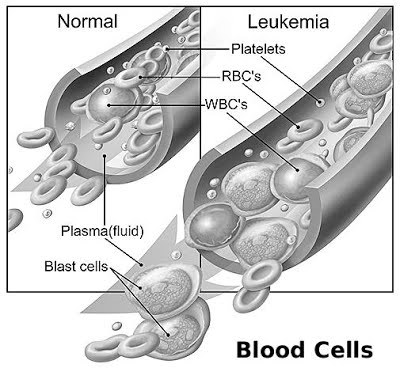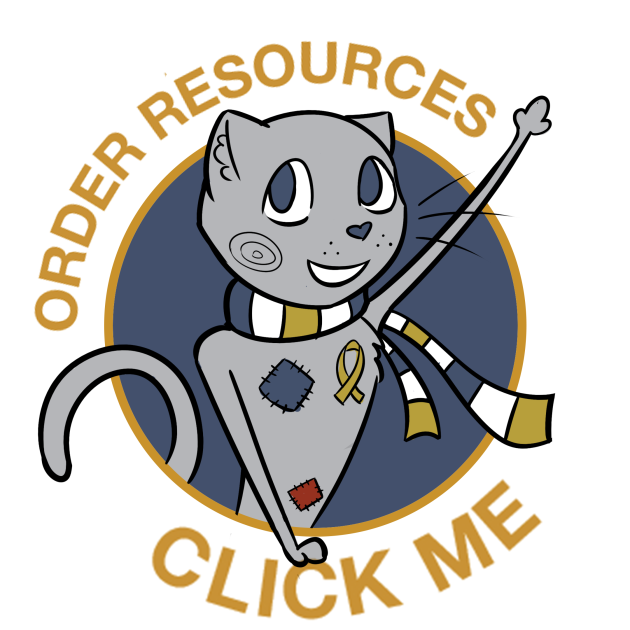About Childhood Leukemia (ALL & AML)
 Childhood leukemia—a blood-based cancer in which abnormal cancer cells grow in the bone marrow—is the most common type of childhood cancer, accounting for almost one-third of all childhood cancer diagnoses. There are three different types of childhood leukemia. The most common type—Acute lymphocytic (lymphoblastic) leukemia, or ALL, accounts for approximately 3 out of 4 cases of childhood leukemia. ALL stems from abnormal cells growth in immature lymphocytes, the white blood cells that help the body fight infection. Acute myelogenous leukemia (AML) accounts for about one out of four cases of childhood leukemia. AML begins with abnormal growth of myeloid cells, which are responsible for the development of non-lymphocytic white blood cells, red blood cells, and platelets. A third type of childhood leukemia—Juvenile myelomonocytic leukemia (JMML)—is extremely rare. Like AML, it develops in the myeloid cells. It is acute (quickly growing) but it does not develop and spread as quickly as AML or ALL.
Childhood leukemia—a blood-based cancer in which abnormal cancer cells grow in the bone marrow—is the most common type of childhood cancer, accounting for almost one-third of all childhood cancer diagnoses. There are three different types of childhood leukemia. The most common type—Acute lymphocytic (lymphoblastic) leukemia, or ALL, accounts for approximately 3 out of 4 cases of childhood leukemia. ALL stems from abnormal cells growth in immature lymphocytes, the white blood cells that help the body fight infection. Acute myelogenous leukemia (AML) accounts for about one out of four cases of childhood leukemia. AML begins with abnormal growth of myeloid cells, which are responsible for the development of non-lymphocytic white blood cells, red blood cells, and platelets. A third type of childhood leukemia—Juvenile myelomonocytic leukemia (JMML)—is extremely rare. Like AML, it develops in the myeloid cells. It is acute (quickly growing) but it does not develop and spread as quickly as AML or ALL.
Symptoms of Childhood Leukemia
Childhood leukemia begins in the bone marrow (the soft core within the bone responsible for the development of blood cells, including red blood cells, white blood cells, and platelets), quickly spreading into the blood stream and potentially crowding out healthy cells our body needs to properly function. Once in the blood stream, cancer cells begin to travel throughout the body and can impact the health of other organs. The symptoms of leukemia often depend on the type of blood cell impacted by the cancer, and whether the cancer has begun to impact other organs.
Red blood cells: Red blood cells are responsible for carrying oxygen from the lungs to every cell in the body. If childhood leukemia has caused a shortage of healthy red blood cells, symptoms can include:
- Unusually pale skin
- Fatigue
- Weakness
- Shortness of breath
- Headaches
- An unusual sensation of cold
- Feeling lightheaded or dizzy
White blood cells: White blood cells help the body fight off illness caused by viruses and/or bacteria. If childhood leukemia has caused a shortage of white blood cells, or prevents the white blood cells from functioning properly, your child may not be able to fight infection properly. Recurring infections or infections that won’t go away even with medical intervention may indicate the presence of leukemia. Fever is usually the main indicator of an infection.
Platelets: Platelets are responsible for helping create blood clots in order to control and stop bleeding. If childhood leukemia has caused a shortage of platelets, symptoms can include:
- Easy and frequent bruising
- Easy bleeding
- Frequent and/or severe nosebleeds
- Bleeding gums
As childhood leukemia spreads from the blood stream into various other organs of the body, it can cause symptoms relating to specific organs, including:
- Bone or joint pain
- Swollen lymph nodes
- Swelling in the abdomen caused by the build-up of cancer cells in the liver and/or spleen
- Weight loss/loss of appetite caused by swelling abdominal organs pressing on the stomach
- Coughing or trouble breathing caused by the build-up of cancer cells near or in the lungs
- Headaches, seizures, vomiting, loss of balance, and blurred vision could be indications that leukemia cells have begun to accumulate in the brain and spinal cord
- Swelling of the face and arms—SVC syndrome—a potentially very serious symptom caused by the build-up of cancer cells in the thymus, leading to pressure on the blood vessel moving blood between the head and arms
- Symptoms more common in children with AML include skin rashes, gum problems (swelling, pain, and bleeding), extreme weakness, extreme tiredness, and slurring of speech
With the exception of serious symptoms such as SVC syndrome and the extreme fatigue and weakness sometimes (although rarely) seen in patients with AML, the most common symptoms of childhood leukemia are also symptoms of many routine childhood illness. Childhood leukemia is a very rare disease, and the presence of one or more of these symptoms does not mean that your child has leukemia. However, it is important to have your child examined by a pediatrician, who will suggest additional diagnostic testing if he or she suspects that the symptoms may be related to childhood leukemia.
Request for free resources here.
More about Childhood Leukemia Cancers:
- About Childhood Leukemia Cancer – Detection and Diagnosis
- Causes, Risk Factors, and Prevention of Childhood Leukemia Cancer
- What are the signs and symptoms of Childhood Leukemia Cancer?
- Childhood Leukemia Cancer Treatment
- What is the expected life span of Childhood Leukemia Cancer?
- After Treatment – Living as a Childhood Leukemia Cancer Survivor



